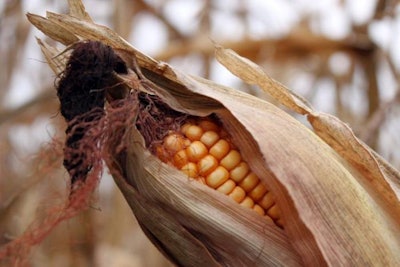
Mycotoxin levels have been a popular topic among those interested in animal nutrition recently.
“One of the very first things we need to consider when we talk about harvest and mycotoxins for ruminants is weather patterns,” said Dr. Max Hawkins, a nutritionist with the Alltech Mycotoxin Management Team. If we think about the weather stresses that this year’s crop had to endure during pollination, late maturity and harvest, we know that there were certainly some areas with above-average precipitation in July and August, even late into the fall. This certainly left an impact on crops, he said.
“Yield does not indicate quality; you could have a record yield and a record level of mycotoxins,” Hawkins said. This year with the cool, wet weather, the late maturity and later harvest, it could really cause more issues. Also, with corn prices still low, producers may try to control corn in storage strictly with aeration, which could result in some issues, he said.
“Last year, we had a lot of spoiled corn in storage that led to some of the highest level of mycotoxins that we had seen in recent years,” Hawkins said. This year could mimic those issues.
High-moisture corn can increase the risk for mycotoxins. While there are some samples of high-moisture corn that do not show mycotoxins, often the high-moisture corn samples did show some level of the issue.
“I would encourage you to get samples tested,” he said.
Proficiency test to determine accuracy of mycotoxin testing
With professionals like Hawkins recommending producers test their samples, there is a need for accurate and consistent testing.
NutriQuest performed a proficiency test to determine the variability and accuracy of labs and quick tests on the market for the analysis of DON (deoxynivalenol or vomitoxin) in corn and distiller's dried grains with solubles (DDGS).
High mycotoxin levels in grains can negatively affect the overall herd health and performance resulting in profit loss for producers. “To make informed feeding decisions, it is crucial to accurately and precisely test grains for mycotoxins. With many lab and quick test options on the market, it can be difficult to determine which is the most reliable,” said Sarah Weiland, nutrition technician with NutriQuest in a report titled, “How accurate and precise are quick tests and labs when analyzing DON (vomitoxin)?”
The testing processes
Five quick tests and seven labs were analyzed in the proficiency test. “Two subsamples of eight corn and DDGS samples were tested on each quick test and sent to labs for analysis. These subsamples were then tested in duplicate, for a total of four readings per initial sample,” Weiland said.
Variability within tests were measured by calculating the coefficient of variation (CV) among the four readings per sample. Accuracy was measured by calculating z-scores using the Virginia Tech mean and standard error for the same samples, and using Youden plots.
Results of proficiency test
According to the report by Weiland, the study showed that large variation exists among quick test options.
“For the five quick tests analyzed, average CV ranged from 7 percent to 22 percent in corn samples and 3 percent to 20 percent in DDGS samples; two systems had CV below 10 percent for both commodities. Average z-scores in corn ranged from 6.97 to 42.80; only two quick tests had average z-scores for corn under 10. Average z-scores for DDGS ranged from 6.67 to 11.51, with three quick tests having average z-scores below 10,” Weiland said while explaining results in the report.
Youden plots confirmed that the quick tests with high CV and z-score assessments had either random or systematic errors in the systems, resulting in inaccurate outcomes. Youden plots also confirmed that labs with high z-scores exhibited high systematic error, leading to inexact results.
Why accuracy matters
“The DON proficiency test demonstrates that when testing for mycotoxins, the quick test or lab used largely impacts the reliability of the data,” said Weiland.
This is especially concerning seeing as level differences considerably change how grain is handled. It also has a lot to do with how grains should be monitored and stored throughout the year.

















